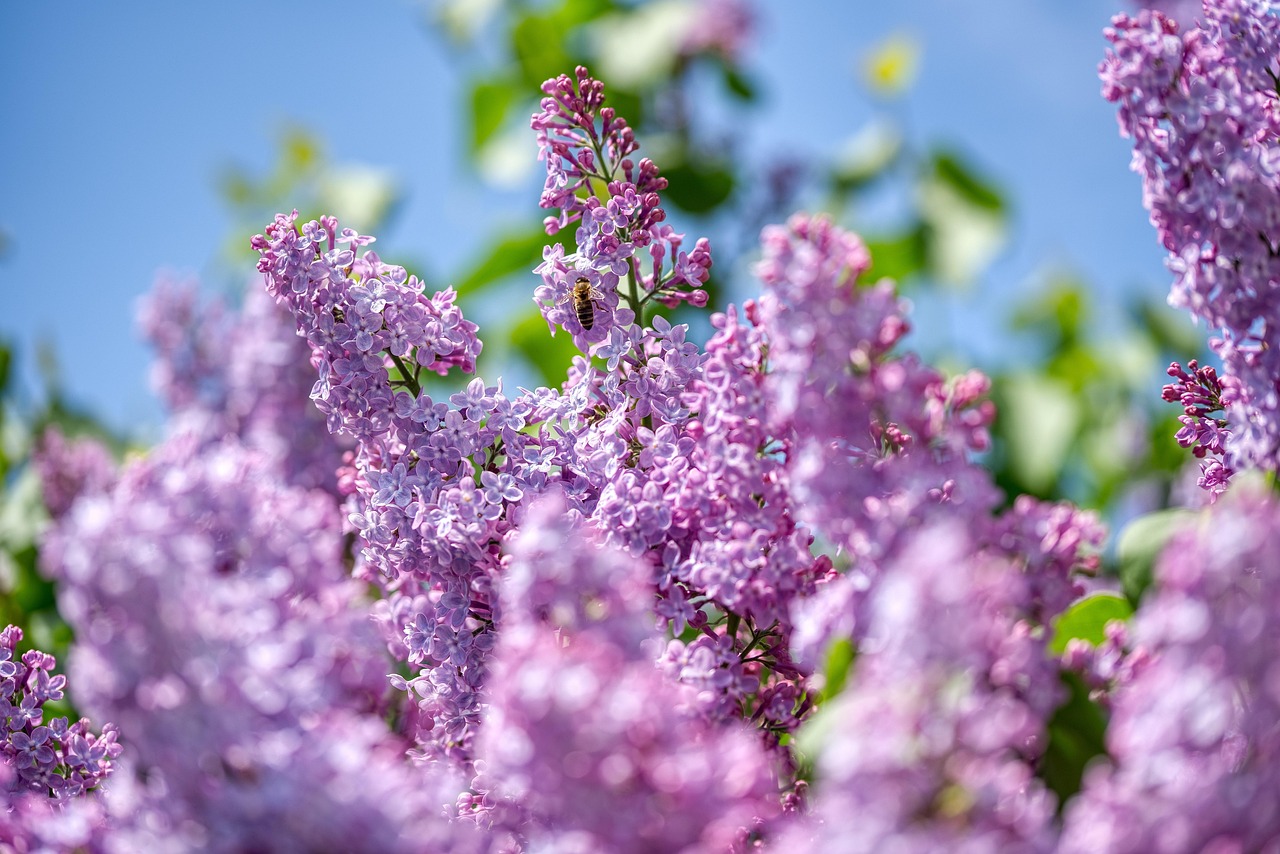Lilac trees typically grow at a moderate rate of 12 to 24 inches per year and can produce fragrant seasonal flowers in spring. Their blooms are known for their delightful scent and vibrant colors, making them popular in gardens and landscapes.
Understanding Lilac Trees
Lilac trees, belonging to the genus Syringa, are cherished for their stunning flowers and delightful fragrance. They are deciduous shrubs or small trees that thrive in temperate climates. Lilacs are particularly famous for their beautiful blooms that appear in spring, attracting pollinators such as bees and butterflies. These plants not only enhance the aesthetic appeal of gardens but also provide a sensory experience with their sweet-smelling flowers.

The most common varieties of lilacs include the Common Lilac (Syringa vulgaris) and the Japanese Tree Lilac (Syringa reticulata). The Common Lilac is known for its vibrant purple flowers, while the Japanese Tree Lilac boasts creamy white blossoms. Both varieties are relatively easy to grow and maintain, making them popular among gardeners.
Growth Rate of Lilac Trees
The growth rate of lilac trees can vary depending on several factors, including the species, soil conditions, climate, and care provided. Generally, lilacs grow at a moderate pace, with an annual increase ranging from 12 to 24 inches. This growth rate allows them to reach maturity in about 3 to 5 years under optimal conditions.
When planting lilacs, it is essential to choose a location that receives full sunlight. Lilacs thrive best in well-drained, fertile soil with a pH level between 6.0 and 7.0. Proper watering and fertilization can also contribute to healthy growth. Once established, lilacs are relatively drought-tolerant and can adapt to various soil types.

Factors Affecting Growth Rate
A variety of elements can impact the growth rate of lilac trees:
- Soil Quality: Nutrient-rich soil promotes faster growth.
- Sunlight: Lilacs require full sun for optimal blooming and growth.
- Watering: Consistent moisture is important, especially during dry spells.
- Pruning: Regular pruning encourages bushier growth and more blooms.
Fragrant Seasonal Flowers
The highlight of lilac trees is undoubtedly their fragrant flowers. These blooms typically appear in late spring, creating a stunning display of color and scent. Lilac flowers come in various shades, including white, pink, purple, and blue. The fragrance of lilacs is often described as sweet and refreshing, making them a favorite choice for gardens and floral arrangements.
Lilacs are also known for their long-lasting blooms. Once they open, the flowers can remain vibrant for several weeks, depending on weather conditions. To ensure a bountiful bloom season, it is essential to plant lilacs in appropriate conditions and provide proper care throughout the year.

Flower Characteristics
| Flower Color | Fragrance Intensity | Bloom Time |
|---|---|---|
| White | Moderate | Late April – Early May |
| Pink | Strong | Mid May |
| Purple | Very Strong | Late May |
| Blue | Light | Early June |
The versatility of lilacs makes them suitable for various landscaping applications. They can be used as standalone specimens, hedges, or mixed borders. Their fragrant flowers not only attract wildlife but also provide an enchanting atmosphere in any outdoor space.
In summary, lilac trees are valued for their moderate growth rate and exquisite seasonal flowers. With proper care and attention, these beautiful plants can thrive in your garden, offering stunning displays and delightful scents each spring.
Care Requirements for Lilac Trees
To achieve healthy growth and abundant blooms, lilac trees require specific care. Understanding their needs in terms of watering, pruning, and fertilization is essential for any gardener. By following these guidelines, you can ensure that your lilacs remain vigorous and beautiful throughout the growing season.
Watering
Watering is crucial for lilac trees, especially during their early years. Newly planted lilacs need regular watering to establish strong roots. Here are some tips for watering:

- Frequency: Water deeply once a week during dry periods. Ensure the soil remains consistently moist, but not waterlogged.
- Method: Use a soaker hose or drip irrigation to deliver water directly to the roots.
- Signs of Stress: Look for wilting leaves or leaf drop, which may indicate that your lilac needs more water.
Fertilization
Proper fertilization can enhance the growth and flowering of lilac trees. Here are some guidelines for feeding your lilacs:
- Type of Fertilizer: Use a balanced fertilizer with equal parts nitrogen, phosphorus, and potassium (N-P-K). A ratio such as 10-10-10 works well.
- Timing: Fertilize in early spring before new growth begins. This timing helps to support the flowering process.
- Application: Follow package instructions for the appropriate amount of fertilizer based on your lilac’s size.
Pruning Lilac Trees
Pruning is an important aspect of lilac care. It helps to maintain the shape of the tree and encourages new growth and flowering. Understanding when and how to prune is vital for optimal results.
When to Prune
The best time to prune lilac trees is immediately after flowering. This timing allows you to remove old blooms while encouraging new growth for the next season. Pruning too late in the year can remove flower buds that have already formed.
How to Prune
Here are some steps for effective pruning:
- Remove Dead or Diseased Wood: Start by cutting away any dead, damaged, or diseased branches.
- Thin Out Crowded Areas: Selectively remove branches that are crossing or growing too close together. This improves air circulation.
- Shape the Tree: Trim back any overgrown branches to maintain a balanced shape and encourage bushier growth.
Pest and Disease Management
Lilac trees can be susceptible to various pests and diseases. Being aware of potential issues can help you take preventive measures and keep your plants healthy.
Pests
Common pests that may affect lilacs include:
- Lilac Borer: This insect can damage the stems and branches. Look for signs of frass (sawdust) and remove affected areas immediately.
- Aphids: These small insects may suck sap from the leaves, leading to curling and yellowing. Use insecticidal soap to manage infestations.
Diseases
Lilacs may also face diseases such as:
- Powdery Mildew: A fungal disease that causes a white powdery coating on leaves. Ensure good air circulation and apply fungicides as needed.
- Leaf Spot: This disease appears as dark spots on leaves. Remove affected leaves and apply fungicides if necessary.
Selecting the Right Location
The location where you plant your lilac tree plays a crucial role in its growth and blooming potential. Here are key factors to consider:
- Sunlight: Lilacs thrive in full sun, so choose a spot that receives at least six hours of direct sunlight each day.
- Soil Drainage: Ensure the planting area has good drainage to prevent root rot. Avoid areas that tend to collect standing water.
- Space: Consider the mature size of the lilac tree when selecting a location. Provide adequate space for growth and airflow.
Propagation Methods for Lilac Trees
Propagating lilac trees can be a rewarding experience for gardeners. There are several methods to propagate lilacs, each with its advantages. Understanding these methods will allow you to expand your lilac collection or share them with friends and family.
Cuttings
Taking cuttings is one of the most popular methods of propagating lilacs. This method involves rooting sections of healthy stems. Here’s how to do it:
- Choose the Right Time: The best time to take cuttings is in late spring or early summer when the plants are actively growing.
- Select Healthy Stems: Look for healthy, non-flowering stems that are about 4 to 6 inches long.
- Make the Cuts: Using sharp, clean scissors, cut just below a node (the area where leaves attach).
- Prepare the Cuttings: Remove the lower leaves, leaving at least two leaves at the top.
- Rooting Hormone: Dip the cut end in rooting hormone to encourage root development.
- Plant the Cuttings: Place the cuttings in a pot filled with moist potting soil. Water them lightly.
- Cover and Maintain: Cover the pot with a plastic bag to maintain humidity. Place it in a warm, bright location but out of direct sunlight.
Layering
Layering is another effective method for propagating lilac trees. This technique allows a stem to root while still attached to the parent plant.
- Choose a Low Branch: Select a low-growing branch that can easily reach the ground.
- Prepare the Soil: Clear the soil where the branch will touch the ground.
- Make a Wound: Slightly scrape the underside of the branch where it will touch the soil to encourage rooting.
- Bend and Bury: Gently bend the branch down to the soil and bury the wounded section in the soil, leaving the tip exposed.
- Secure the Branch: Use a rock or stake to hold the branch in place if necessary.
This method may take several months, but once roots develop, you can cut the new plant from the parent and transplant it.
Choosing Lilac Varieties
There are many varieties of lilacs, each with unique characteristics. Choosing the right variety for your garden can enhance its beauty and fragrance. Here are some popular lilac varieties:
| Variety | Color | Mature Height | Bloom Time |
|---|---|---|---|
| Syringa vulgaris (Common Lilac) | Purple, White, Pink | 8-15 feet | Mid to Late Spring |
| Syringa reticulata (Japanese Tree Lilac) | Creamy White | 20-30 feet | Late Spring |
| Syringa palibiniana (Dwarf Korean Lilac) | Lavender | 4-6 feet | Early to Mid Spring |
| Syringa meyeri (Meyer Lilac) | Pale Purple | 4-5 feet | Mid Spring |
When selecting a variety, consider factors such as height, bloom time, and color preferences. Each variety has unique growth characteristics that can complement your landscape design.
Cultural Significance of Lilacs
Lilacs have held cultural significance across various societies for centuries. Their beauty and fragrance have inspired art, literature, and traditions around the world.
Symbolism
Lilacs are often associated with love and renewal. Different colors carry distinct meanings:
- Purple Lilacs: Symbolize first love and innocence.
- White Lilacs: Represent purity and innocence.
- Pink Lilacs: Signify love and affection.
Lilacs in Literature and Art
Lilacs have appeared in numerous works of literature and paintings. Poets and writers have described their beauty and fragrance as symbols of spring and rebirth. Famous artists have incorporated lilacs into their floral compositions, celebrating their vibrant colors and delicate forms.
The enduring appeal of lilacs makes them a beloved choice for gardens, public parks, and landscapes worldwide. Their rich history adds depth to their allure, making them more than just beautiful plants but symbols of nostalgia and love.
Environmental Impact of Lilac Trees
Lilac trees not only enhance the beauty of gardens but also play an essential role in the environment. They contribute to the ecosystem in various significant ways, making them a valuable addition to any landscape.
Attracting Pollinators
Lilacs are known to attract a variety of pollinators, including bees and butterflies. Their fragrant blooms are a source of nectar, which supports these vital insects during the spring season. This attraction aids in pollination, benefiting not only lilacs but also other plants in the vicinity that rely on pollinators for fruit and seed production.
Supporting Biodiversity
By planting lilac trees, gardeners can create habitats for various wildlife species. The dense foliage and structure of lilacs provide shelter and nesting sites for birds and small mammals. Additionally, they contribute to the overall biodiversity of an area by providing food sources and habitats for a range of organisms.
Soil Health Improvement
Lilac trees can also enhance soil health. Their roots help to aerate the soil and improve drainage, which benefits surrounding plants. Moreover, lilacs can contribute organic matter to the soil when leaves fall and decompose, enriching the soil with nutrients.
Landscape Design Ideas with Lilacs
Incorporating lilac trees into your landscape can create stunning visual effects and enhance your outdoor space. Here are some ideas for using lilacs effectively in garden design:
Mixed Borders
Planting lilacs alongside other flowering shrubs and perennial plants creates a mixed border that changes with the seasons. Consider pairing lilacs with:
- Roses: The combination of lilac and rose blooms offers a beautiful contrast of colors and fragrances.
- Daylilies: Their vibrant flowers can bloom at different times, ensuring continuous color throughout the growing season.
- Hostas: The lush foliage of hostas complements the blooms of lilacs beautifully, adding texture to the garden.
Hedgerows
Lilacs can be used to form hedgerows, providing privacy and defining space in your yard. A hedge of lilacs can serve as a natural barrier while offering seasonal beauty and fragrance. Ensure proper spacing for air circulation and light penetration for optimal growth.
Specimen Plantings
A single, well-placed lilac tree can serve as a focal point in your garden. Choose a variety with striking flowers or unique foliage and plant it where it can be appreciated fully. Surround it with low-maintenance ground cover to highlight its beauty.
Challenges of Growing Lilac Trees
While lilac trees are generally easy to grow, they do come with some challenges that gardeners should be aware of to ensure successful cultivation.
Climate Sensitivity
Lilacs thrive in temperate climates and may struggle in extremely hot or humid regions. If you live in an area with harsh summers, consider planting lilacs that are more tolerant of heat and humidity.
Flowering Issues
One common issue gardeners face is a lack of flowers. This can result from inappropriate pruning, insufficient sunlight, or poor soil conditions. To promote blooming:
- Ensure that you prune immediately after flowering.
- Provide full sun exposure to maximize blooming potential.
- Regularly amend the soil with organic material to improve fertility.
Conclusion
Lilac trees are a remarkable addition to any garden, offering both aesthetic beauty and environmental benefits. Their moderate growth rate allows them to flourish in various landscapes, while their fragrant blooms create an enchanting atmosphere during the spring season. By understanding their care requirements and incorporating them thoughtfully into garden designs, you can enjoy their beauty for years to come.
The cultural significance of lilacs further enriches their presence in our lives. As symbols of love, renewal, and nostalgia, they remind us of nature’s beauty and its ability to evoke emotions. Whether through propagation, planting, or simply enjoying their fragrance, lilac trees provide countless opportunities for connection with nature.
In summary, lilacs are not just beautiful flowering trees; they are beneficial to both our gardens and the environment. With proper care and thoughtful placement, these lovely plants can thrive, providing joy and beauty for generations to come.
